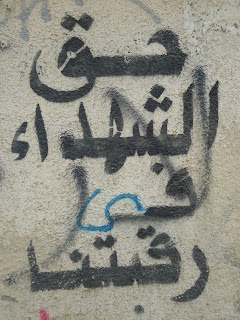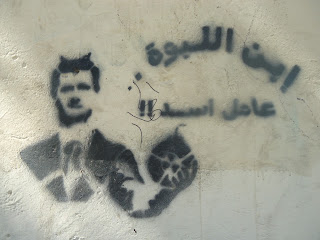For those of you who are not familiar with the Cairo layout, Zamalek is a large island neighborhood in the Nile. Across the river to the east is downtown Cairo (Tahrir) and to the west is Mohandseen (part of greater Giza). The residents of Zamalek tend to be either wealthy Egyptians or foreigners.
There is noticeably less street art here and a good proportion of it isn't even relevant to the protests ('free Palestine' statements, feuding between the football clubs 'Ahly and Zamalek, etc). Compared to the angry street art of downtown Cairo, it has much more of a positive and idealistic tone.
*On a sidenote, I discovered a tunnel- I've nicknamed it the 'tunnel of love'- where teenagers just hang out and confess their crushes in the form of graffiti
The political posters that hang in Zamalek support secular, liberal candidates such as Hamdeen Sabahi, Amr Moussa, and Khaled Ali.
25 of January. Equality. Freedom.
(25 of January 2011 was the day the uprising began in Tahrir; the crescent and cross image represents unity between Egyptian Muslims and Coptic Christians)
Fly high with freedom
(reference to the martyrs of Tahrir)

A prisoner breaks his shackles through the power of social media- Facebook, SMS.
(tribute to the important role that social media played in the uprisings)
A mocking depiction of the "eye sniper"
(an Egyptian police officer infamous for aiming at the eyes of protesters in Tahrir)
No to harassment
(this image is all over Zamalek, Gezira, and downtown)
One of the longest surviving pieces of street art in Cairo- this tank once pointed at a bread delivery boy on a bicycle... except instead of carrying a platter of bread on his head, he was carrying the weight of the city. According to the artist, Mohamed Fahmy, this piece predicted a collision between Cairo's youth and the military regime.
(from right to left) Tahrir. Identify yourself with the revolution (2 km)
Tahrir. Here is your address
Tahrir. Come see us yourself (2 km)
"Hosni not Hussein," depiction of Hussein Tantawi
(Chairman of SCAF and Commander-and-Chief of the Egyptian Armed Forced)
Hamdeen Sabahi. One from (among) us. Image/character of the eagle
(the eagle was Sabahi's symbol on the ballots to accommodate illiterate people; Hamdeen Sabahi is a liberal activist and ex-presidential candidate before he was knocked out of the race in the first round of elections- he was extremely popular among the liberal, anti-Shafiq crowd as well as the Egyptian expat community)
Khaled Ali. Livlihood, freedom, and social justice
(Khaled Ali was also a liberal presidential candidate knocked out in the first round of elections. Some people blame him for splitting the liberal vote with Hamdeen Sabahi, who placed only several percentage points behind Shafiq
)






































